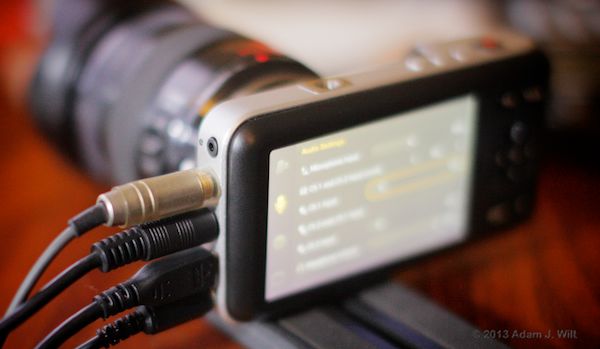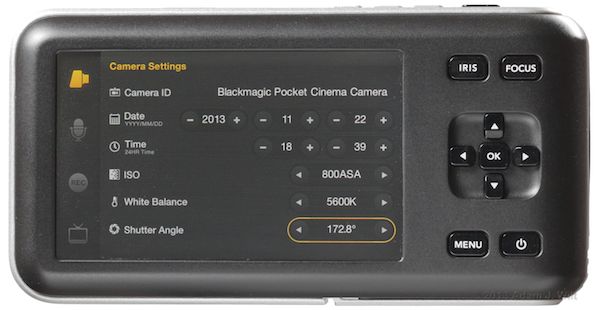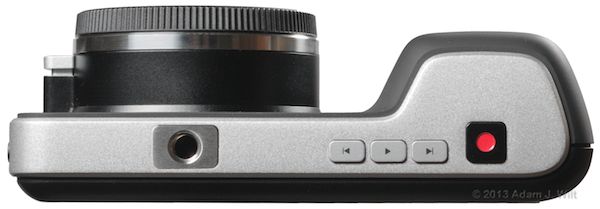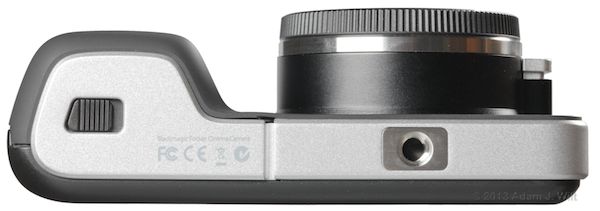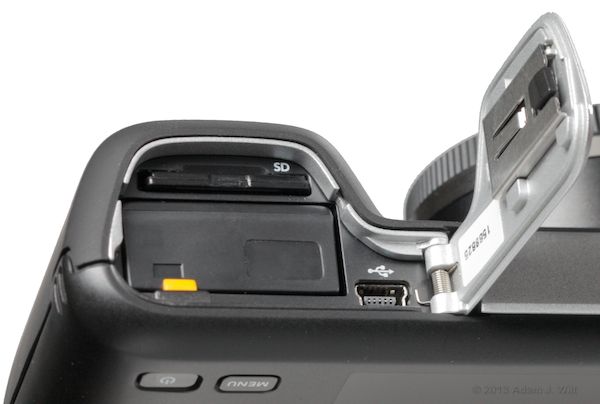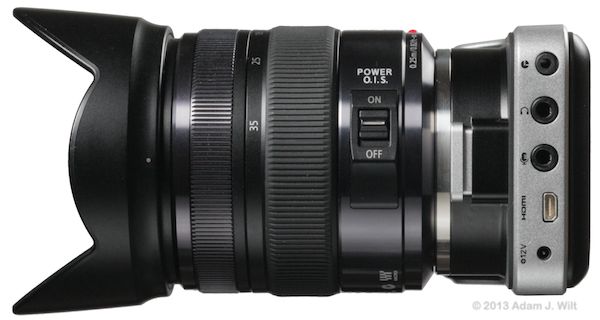Pocket Cinema Camera
The Pocket Cine Cam is clearly cut from the same cloth, but with much tinier scissors. It’s only 5 inches wide, 2.6 inches tall, and a mere 1.5 inches long (126mm x 65mm x 38mm), and the body weighs 12.5 oz or 0.35 kg. It’s so small and light that it wasn’t really practical to tripod-mount it for its beauty shots, so I stuck it on a Noga arm instead:
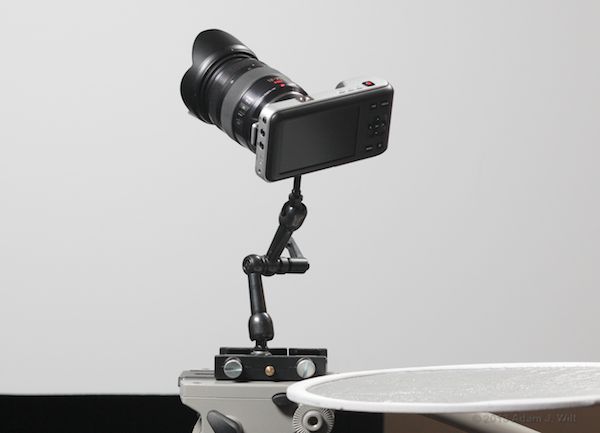
Indeed, its diminutive stature is an issue when using large-diameter lenses that extend below the tripod socket – and “large” means anything over about 2.5 inches in diameter, like the Lumix 12-35mm f/2.8 in the photo above. Pocket Cine Cam users will need risers or other adapters to stick this puppy on a ‘pod, unless they wind up hanging it off the edge of their tripod plate as Brian Hallett has done, and as I did during my tripedal testing: I screwed the camera down as close to the front edge of my Manfrotto 357 sliding plate as I could, and cantilevered it off the front of the head.
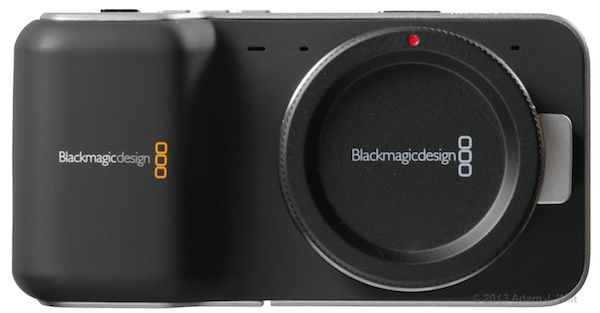
The front of the camera has two small ports for the built-in stereo microphones, plus another larger one for the built-in speaker. A silver button releases the lens lock. As with the larger camera, the front of the Pocket is a grippy rubberized surface, from which the black metal lens mount protrudes.
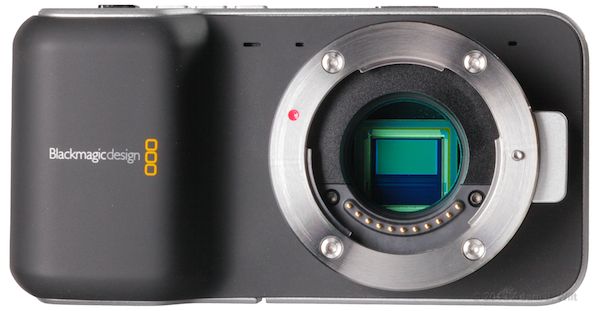
Pop the body cap off to reveal the lens contacts and the 12.48mm x 7.02mm sensor: only 3% smaller than Super16mm; about 66% the size of most MFT sensors, and about half the size of Super35mm. Small? It’s still 50% bigger than 2/3″, twice the size of 1/2″, and about three times the size of a 1/3″ chip.
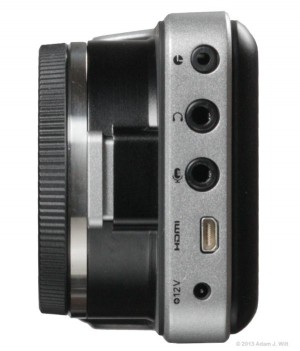 The perimeter of the camera, with the exception of the right-side grip area, is wrapped in matte magnesium alloy. Connector ports fill the left side of the camera; there are no dust caps or doors hiding them.
The perimeter of the camera, with the exception of the right-side grip area, is wrapped in matte magnesium alloy. Connector ports fill the left side of the camera; there are no dust caps or doors hiding them.
At the top is a 2.5mm LANC port; as with the Cine Cam, the Pocket Cine Cam allows start/stop, and lens focus & iris control with compatible lenses. Unlike the larger cam, the Pocket worked with my RM-95 controller, letting me run the camera and focus my lenses (the RM-95 doesn’t have an iris control, so I couldn’t test that). One-push AF on the RM-95 was ignored, but the near/far buttons worked. Response speed was lens-dependent. The Lumix 20mm f/1.7 focused so slowly that at first I thought it didn’t work at all, an Olympus 45mm f/1.8 was so fast it was difficult for me to stop where I wanted to, and the Lumix 12-35mm f/2.8 was just right.
3.5mm jacks handle stereo headphones out and stereo line/mike audio in. A micro-HDMI port feeds 1080p video out, with embedded audio. A 2.5mm coax port (the center pin is only 0.7mm!) allows 12-20VDC power input (tip positive) to turn the camera and/or charge the battery.
Folks often criticize little cameras for “nonprofessional” connectors, but even with these small plugs, the side of the camera gets crowded.
The back of the camera is dominated by the 3.5″, 800×480 LCD. The back panel is smooth, molded plastic, not the rubbery material used on the front. The LCD is not a touchscreen; instead, four-way buttons are used to navigate the menus, and the OK button replaces a screen tap. The screen shows essentially the same displays as the bigger screen on the larger camera: the same single-line status readout when showing the picture, or the full-screen menu display (discussed in detail later on). However, the battery gauge on the Pocket reads out with single-percent resolution, instead of the 25% steps of the Pocket’s bigger brother. Don’t get too cocky with it; I had the Pocket shut down on me when, to the best of my recollection, the battery meter still indicated a charge of around 8%.
Again, IRIS is a one-push autoexposure aperture-setter. The Up and Down arrow key are used for manual, quarter-stop iris adjustment. FOCUS, pushed once, triggers autofocus (that it, it causes the lens to be focused, once. There is no continuous autofocus mode); pushed twice, it toggles peaking.
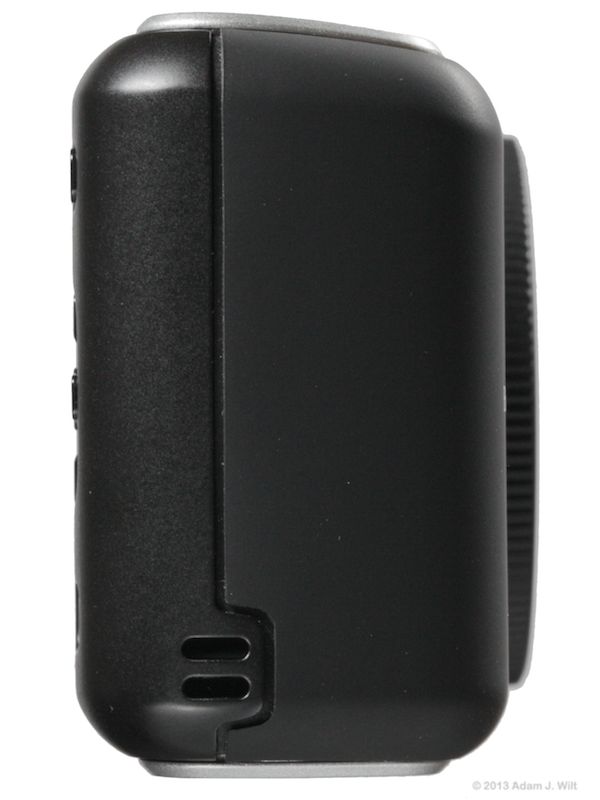 Pushing OK once displays the slate panel and pushing it twice toggles pixel-for-pixel viewing.
Pushing OK once displays the slate panel and pushing it twice toggles pixel-for-pixel viewing.
Again, I wonder at the single- vs. double-tap design on both these controls; I’d prefer the single taps to toggle peaking and pixel-for-pixel, and double-taps for slate and one-shot AF.
The right side has a lug on the bottom for a wrist strap (supplied with the camera), but it is otherwise featureless. The smooth black back wraps around to meet the rubbery material used on the front, which flows around the bulging handgrip containing the battery and the SD card slot.
The top of the camera has a 1/4″ accessory mounting socket, and three transport controls used for playback. Unlike the Cine Cam, the Pocket lacks a “stop” button to exit playback: simply press the Record button instead. When already in live view, the Record button starts and stops recording.
Under the Pocket Cine Cam there’s another 1/4″ tripod socket. Both the 1/4″ sockets are part of hardened mounting points; the lower one is flush with the surrounding metal while the upper one is raised slightly (the top panel of the camera slopes gently towards the front, and the raised mount allows it and any attached accessories to to be mounted perfectly vertically without interfering with the top panel). A large door – well, “large” is a relative term, grin – covers the battery and media slots.
The battery is an EN-EL20 type such as you might have seen on Nikon DSLRs. It lasts for around an hour; most Pocket Cam users get a handful of aftermarket EL20s to get ’em through the day. The recording medium, an SD card (!), fits into a slot ahead of the battery. A USB port allows firmware updates with the Blackmagic Camera Utility.
Take a close look at that picture. See how the metal framework is cut away to allow for the corners of the battery to slide past? If the camera got much smaller, the battery wouldn’t fit at all!
Again, fit and finish are well beyond what you’d expect for a $995 motion picture camera. The camera’s handgrip bulge is nicely sized, and its rubber surface helps immobilize the camera in your hand even as the smoother back panel lets your thumb slide around to find and press the various buttons. Yes, the controls are a bit crowded together – did I mention the camera is small? – and I couldn’t decide whether the record trigger was best pressed with my forefinger, coming ’round the side, or my thumb, reaching over the back (I wound up using the two digits equally frequently). I also found the four-way arrows and the OK button a bit too close and hard to distinguish by feel: I often wound up displaying the slate when I was trying to open or close the iris.
The screen is very crisp, but its comparatively weak backlight and semi-matte surface do it no favors in outdoor use. While it’s fine indoors and on cloudy days, seeing anything on it in a sunlit environment is difficult, and well-nigh impossible if sunlight is falling directly on the screen itself.
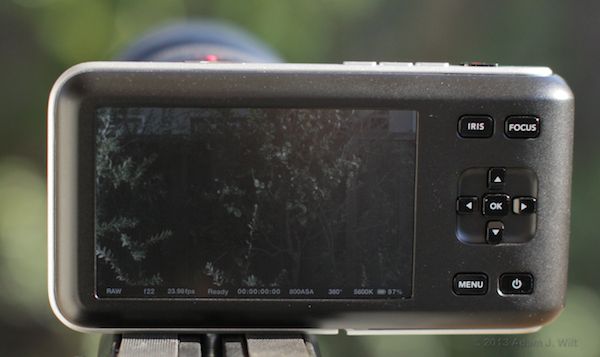
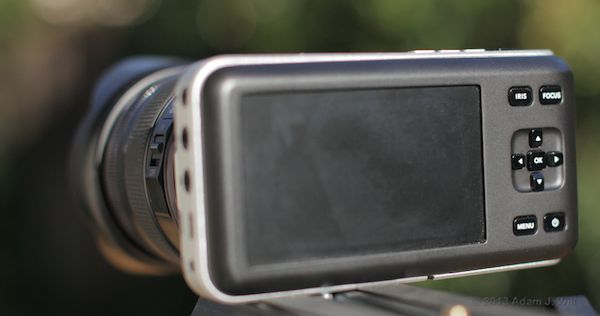
No, those aren’t smudges on the screen, highlighted by late-afternoon November sunlight: that’s the picture. I found the unshaded screen usable only when (as in the first photo) the sun was directly above or to the side; sunlight shining on the screen made it impossible to view, while having the sun in front of the camera – backlighting the subject – glared in my eyes and obscured the dimmer LCD in veiling flare (perhaps I need multicoated eyeballs).
The semi-matte finish does an excellent job of picking up any reflections in the area and using them to wash out whatever contrast survives the sunlight. Michael Reichmann (same link, if you haven’t read him already) also notes that the screen is fragile and easily scratched, though I didn’t test this myself.
Mr. Reichmann recommends a Zacuto Z-Finder loupe for the Pocket; there’s a picture of it in his review, but it’s not on the Zacuto site as I write this. I would agree that some sort of hood or loupe is recommended for using the Pocket outdoors… or a separate EVF (for either camera, about which more will be said later).
Those quibbles aside, it’s a joy to use handheld. It weighs almost nothing when equipped with most MFT primes or short zooms. Many of the zooms offer optical stabilization, which is enabled during recording. True, it’s still a lightweight camera floating around in your hand, but it’s small enough and compact enough that such usage is possible without stress or strain. If you want the stability of a body brace or shoulder mount, or an eye-level EVF, these can always be added, but you can capture imagery quite comfortably with an unencumbered camera and a lightweight lens.
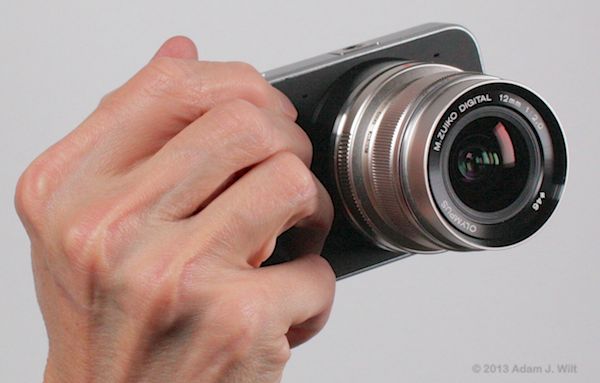
Using the camera on a tripod or other support depends on having clearance between the tripod base and the lens. Let’s see what that’s an issue:
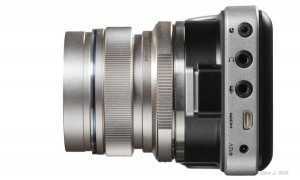
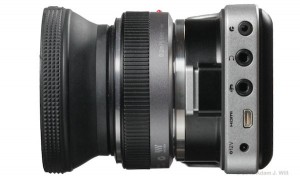
With a small prime, like the Olympus 12mm f/2 or the Lumix 20mm f/1.7, there’s no problem. Both lenses are small enough (aside from the rubber shade on my 20mm) that they won’t interfere with a large tripod plate.
With the Lumix 12-35mm f/2.8, we’re pushing our luck: the rearmost part of the lens barrel, behind the O.I.S. switch, will clear the tripod plate, but everything forward of that point is too fat to fit.
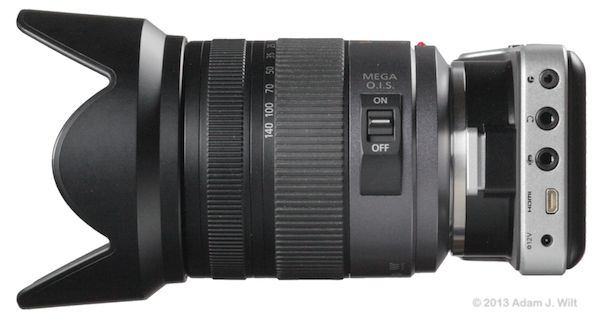
Even the rearmost section of the barrel on the 1st-generation Lumix 14-140mm is too big for unobstructed tripod work.
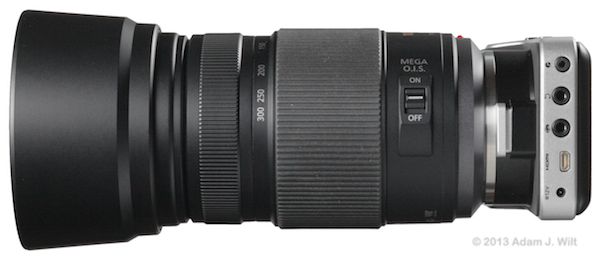 And the Lumix 100-300mm is so large that the camera itself almost disappears.
And the Lumix 100-300mm is so large that the camera itself almost disappears.
Now, none of these lenses is what you call big, as far as big lenses go, it’s just that the Pocket is so darned small.
Fortunately, two of the go-to lenses for this camera are thin enough (at least until you get to the front elements or lens shade) that tripod mounting isn’t a concern:
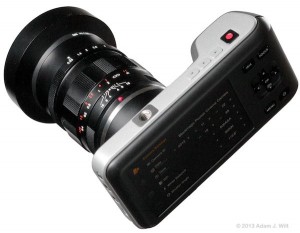
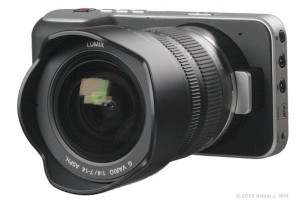
The Nokton 25mm f/0.95 and the Lumix 7-14mm f/4 both allow tripod use over most of their length, and if you take the lens shade off the Nokton, the entire lens is small enough.
Of course, you can get riser platforms or cages, or just switch to lenses that have their own mounts, like the Nikkor 70-200mm f/2.8:
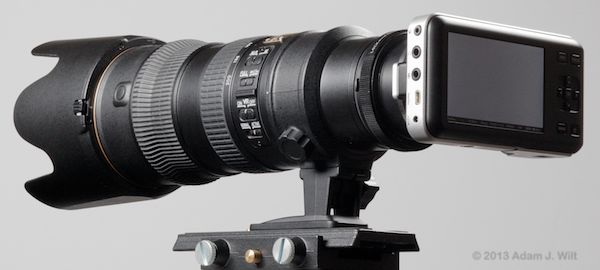
The Pocket attaches with an MFT-to-F-mount adapter and hangs on for dear life, like a remora clinging to a shark.
Next: Menus and Operations…

